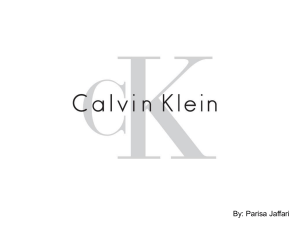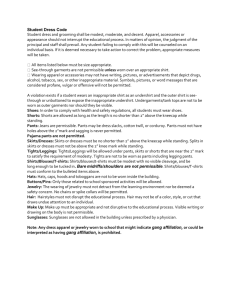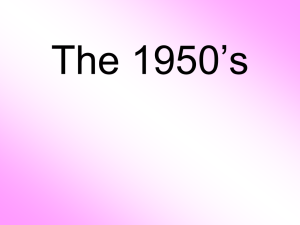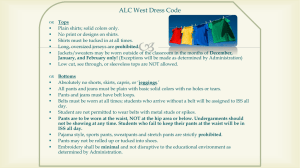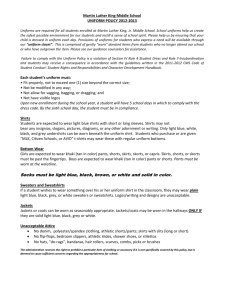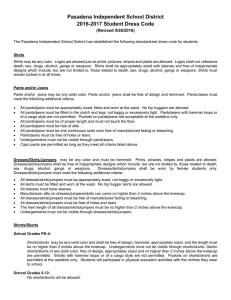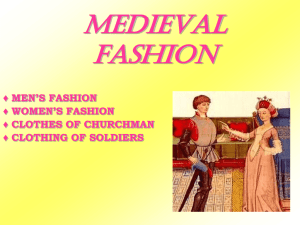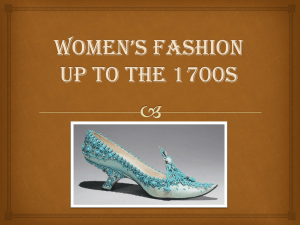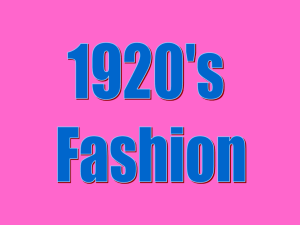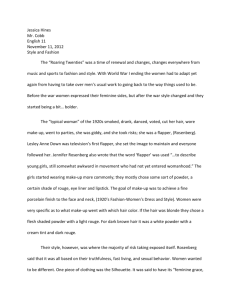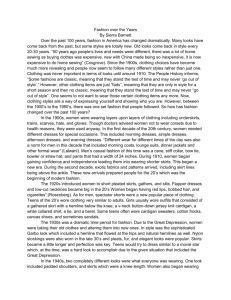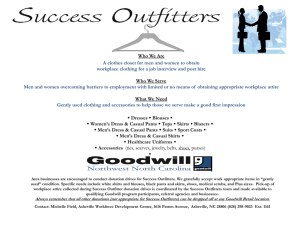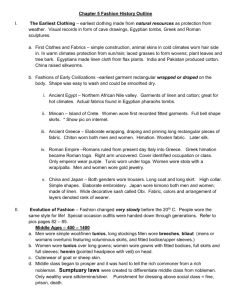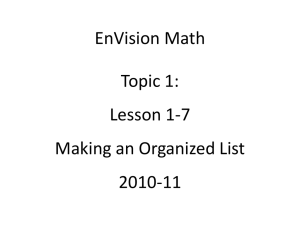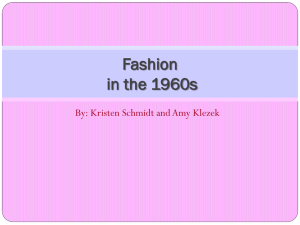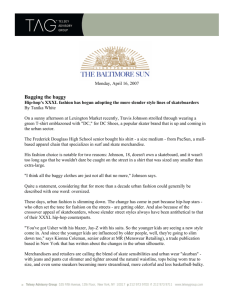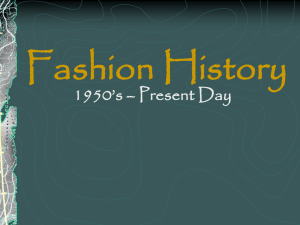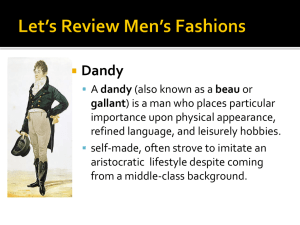Fashion History PP
advertisement
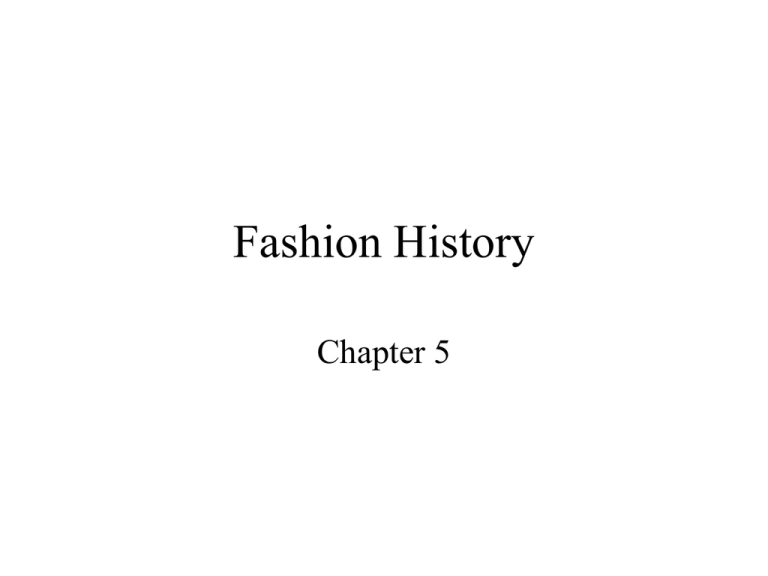
Fashion History Chapter 5 The Earliest Clothing • Made from natural resources as protection from weather – – – – Animal skins and hair plants grasses tree bark Fashions of Early Civilizations Ancient Egypt Made from lightweight linen and cotton which made them suitable for the hot climate MEN • Knee-length skirts tied in the front • Sleeved shirt-like garment completed their outfits WOMEN • Long, straight dresses that tied behind the neck or at the shoulder. The Evolution of Fashion • Many years ago, fashion changed very slowly • People often wore the same styles their entire life • Sometimes even generation to generation Fashions of the Twentieth Century 1900-1950 • During WWI, more women worked in shops, offices and factories, so more practical clothing developed. • Looser garments, such as sweaters and middy blouses with sailor collars, became popular. 1920s • Flapper Dresses – Straight and short – Adorned with fringe or flounces – Worn with long string beads 1930s MEN • Unchanged in this same period. Both single-and doublebreasted suits were popular. WOMEN • Became active in sports which encouraged wide trousers and abovethe-knee shorts to participate • Evening gowns were long and formfitting 1940s • Both women and women wore tailored suits with broad, padded shoulders. • During WWII, a shortage of fabric occurred because so many textiles were used for military uniforms and equipment. Football Team • With the fashion industry closed down by the war in Europe, the designers turned to the military for inspiration. • The “bomber jacket” was based on the Air Corps flying coat made of leather with knit wrist cuffs to keep out the wind. This woman was married in a suit quickly for her husband to be shipped out. 1940s • Women’s skirts became slimmer and shorter due to fabric rationing. • Nylon stockings were almost impossible to get, so women wore cotton stockings • Slacks and jumpsuits became the standard work clothes for women as they replaced men in factories Fashion and War Restrictions Stockings were expensive and usually not available! 1947- “The New Look” • Softer, more feminine look • Stylish, elegant and reflected the opposite of wartime restrictions • Hemlines fell to just above the ankle • Skirts were incredibly full • The shoulder pad was taken out to eliminate the squared, manly look 1950s • Dior introduced the A-line silhouette for women • Full skirts were worn with crinolines and paired with sweater sets. • Pants were rolled up or cropped for casual wear. 1950s • Men’s fashions featured the gray flannel business suit--- single-breasted and loosely fitted, with narrow lapels and natural shoulders. • Worn with a button-down oxford with a narrow tie (Ivy League look) • Dress shirts were now pale blue and yellow not just white anymore. 1950s • The T-shirt came out from under the dress shirt influenced by James Dean • The former undershirt was now worn on its own with blue jeans • Leather jackets were popular • Young women wore a man’s shirt over a pair of cuffed jeans with saddle shoes or white bucks. 1960s • The influence of fashion designers declined and cultural events such as the Beatles, Woodstock,and rock concerts. • First Lady Jacqueline Kennedy became an important fashion leader for women, popularizing the Chanel suit and pillbox hat. 1960s • Many young men started wearing colorful fabrics and jewelry • Men wore multi-colored, striped or check shirts with their business suits • Jacket lapels widened and pants were flared or bell-bottomed. • Men grew long side-burns, mustaches, or beards to go with longer hair lengths. 1960s • Women’s fashion focused on the miniskirt, which kept rising throughout the decade • Pantyhose were introduced and boots became the “in” accessory. • African Americans rediscovered tradtional African garments made of kent cloth. Afro hair styles and cornrow braids were widely worn by both men and women. 1970s • Mid- and maxi-length skirts were introduced. • Women wore more and more pant suitswhich gained acceptance for all occasions • The unisex look was very popular • Men and women wore the same styles in the same fabrics and colors. 1970s • Men wore the polyester pant suit to work • Bright floral shirts were worn without ties • The shirt collar rolled over the jacket collar for a casual look • Jeans became fashionable • T-shirt had slogans printed on the front • Hiphugger pants were worn 1980s • • • • Broad, padded shoulders Skirt lengths ranged from short to long Designer jeans became a status symbol Warm-up suits were worn for jogging and for street-wear • The standard outfit for yougn people consisted for jeans, a shirt or sweater and athletic shoes. 1980s • Styles were influenced by Madonna, Cyndi Lauper, Prince, and Michael Jackson 1990s • Baggy pants to tight leggings; from oversized shirts to skinny tops. No longer did one style dominate. • Styles from the past decades re-emerged in the middle 1990s. Consumers were attracted to fitted jackets from the 1950s, sheath dresses from the 1960s and wrap dresses and hiphugger pants from the 1970s. 1990s • Casual business attire created a new clothing category for men-- allowing khakis and no ties Today
